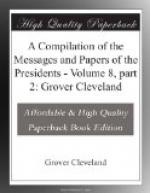At that moment, when the interior of the country was unknown, the adoption of the St. John as the boundary, even admitting that the Walloostook, its southwestern branch, is the main stream, would have given to the United States a territory of more immediate value than that they now claim. For this very reason the proposition was instantly rejected by Great Britain, and the State of Massachusetts was forced to be contented with the distant region now in debate—a region then believed to be almost inaccessible and hardly fit for human habitation.
Even now, were there not vested private rights on both sides which might render such a plan difficult of application, the undersigned would not hesitate to recommend that this line should be accepted in lieu of the one which is claimed under the treaty of 1783.
It is finally obvious, from the most cursory inspection of any of the maps of the territory in question, that the line claimed for Great Britain in the argument before the King of the Netherlands fulfills no more than one of the two conditions, while that of Messrs. Featherstonhaugh and Mudge fulfills neither; and as the line claimed on the part of the United States is denied to be capable of meeting the terms of the treaty of 1783 by Great Britain, there is no line that, in conformity with the British argument, can be drawn within the disputed territory or its vicinity that will comply with either of the conditions. This is as well and as distinctly shown in the map of Mitchell as in the map of the British commission. It would therefore appear, if, these views be correct, that the framers of the treaty of 1783 went through the solemn farce of binding their respective Governments to a boundary which they well knew did not and could not exist.
V.—NORTHWEST HEAD OF CONNECTICUT RIVER.
The true mode of determining the most northwesterly of any two given points need no longer be a matter of discussion. It has already been a matter adjudicated and assented to by both Governments, in the case of the Lake of the Woods. The point to be considered as most to the northwest is that which a ruler laid on a map drawn according to Mercator’s projection in a direction northeast and southwest and moved parallel to itself toward the northwest would last touch. In this view of the subject the Eastern Branch of the Connecticut, which forms the lake of that name, is excluded, for its source, so far from lying to the northwest of those of the other two branches which have been explored, actually lies to the south of the source of the Indian Stream. The question must therefore lie between the two others, and it is as yet impossible to decide which of them is best entitled to the epithet, as their sources lie very nearly in the same northeast and southwest rhomb line. Another circumstance would, however, render the decision between them easy. The forty-fifth parallel of




